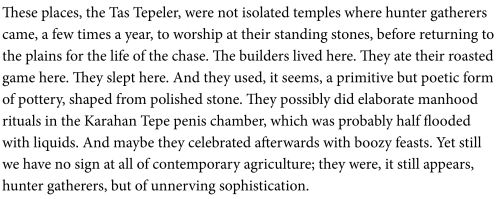#tas tepeler
—Sean Thomas, “Is an Unknown, Extraordinarily Ancient Civilisation Buried Under Eastern Turkey?”
The answer appears to be yes. As we saw last year, with the discovery of these sites over the last few decades, it appears the experts’ picture of human history has changed in ways that haven’t yet filtered out into pop culture.
First, civilization is much older than we thought and may pre-date the rise of organized agriculture—may in fact be religiously inspired rather than religion’s having been the ideological excrescence of human settlement. Cult, cultus, culture: this is where we start; this is who we are. And this, to my mind, deals a welcome blow to the dull and depressing fetish of cultural materialism, i.e., explaining our ideas by our circumstances, as if we were just the playthings of the environment and our hapless attempts to accommodate ourselves to it, rather than imaginative agents renovating the world in the name of metaphysics and aesthetics.
If the religious origin of civilization is cheering, however, this new deep history is also brutal and unsentimental: we can’t blame agriculture for hierarchy and patriarchy anymore, since it appears there was no peace-loving egalitarian goddess cult in the womb of time, but only sacrifice on the altar of the phallus all the way down. I wonder: might agriculture itself have been the matriarchal innovation? “Come away from the great stone chambers of your penile death cult and settle down on the farm, man—pray on the hearth to mother earth for the harvest.” An unwarranted speculation, I’m sure.
I don’t mean to disparage the expertise of archeologists and related investigators; it’s just that my own life in academe as a student of modern literature was spent observing fierce feuds over the meaning of texts written within the last 100 years in our own language by people who were the contemporaries of our parents and grandparents. So the significance of objects 13000 years old from a barely-understood alien civilization is probably a permanent mystery, especially when you consider the wit and irony, as well as sincerity and solemnity, with which we as a species like to deck our imaginative productions, even in worship.
I re-watched the great film Altered States (1980) last night, that doomed confrontation between director Ken Russell and writer Paddy Chayefsky over a hallucinatory parable about a scientist dangerously seeking human origins. Pauline Kael, insulting the film, actually described what’s pleasurable about it: “Russell, with his show-biz-Catholic glitz mysticism, and Chayefsky, with his show-biz-Jewish ponderousness.” The movie’s moral—one thing, I think, Catholics and Jews can agree on, in defiance of our modern gnostics—is that there’s no great truth to be found in the primordial, but merely the baleful chaos out of which we were lucky enough to climb to build the works of intelligence and love.
The skull-piled phallic death chamber—if that’s what it is—is an imperfect example, we might say, still more than half chaos, not yet illuminated by the insight of proper religion and art, which is that you don’t actually have to kill anything for the chaos-calming ritual to work, but a wrong step in the right direction nevertheless. If it started earlier than we thought, and possibly from imaginative promptings alone, so much the better.
Post link



